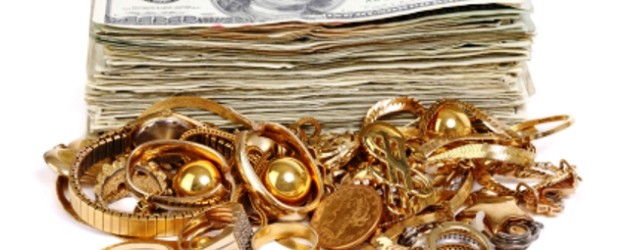In today’s swerving economy, stocks are out, and gold is in. Selling gold has for centuries been a way to make instant cash if you know the basics and what to look out for. When the price of gold goes up, gold fever often ensues and people jump to sell their gold jewelry or coins. However they may not always be getting the best deal. That is why VA Gold Buyers offers advice to consumers who want to know how and when to sell their gold jewelry.
So how do you cash in?
If you’re like thousands of Americans, you go to a gold party, where you can have your jewelry appraised at a friend’s house and get paid cash on the spot.
But wait a second! First you should do some homework before selling your jewelry at gold parties or in a local jewelry store. If you want to get the most cash for your jewelry, follow these tips below to make sure you’re getting the best value for your gold.
1. Understand the Scales
The weight of gold helps determine its value, but keep in mind that some jewelers may use different measurement standards: Troy ounce, pennyweights or grams.
U.S. scales reflect that 28 grams = 1 ounce, while gold is measured at 31.1 grams per Troy ounce. And a pennyweight (dwt) is the equivalent of 1.555 grams. Confused yet? Well not to worry, just be sure that the dealer who weighs your gold pays you based on that unit. In other words, if he weighs it in pennyweights, make sure he pays you based on that vs. by the gram. Most online sites like Kitco.com show the current price of gold or silver per ounce, so a good trick is to write down the conversions that day before walking in the store.
2. Know Your Karats
Pure gold is too soft to be practically used so it is combined with other metals to create durability and color. That is why the gold you wear is either 18k or 14k, an allow of the pure metal. Every piece of jewelry normally has a stamp somewhere internally which identifies the alloy: 10k, 14k, 22k for gold or .999 for silver. Karats show the gold content. It is important to know the karats of your gold jewelry to make an informed decision on the scrap value of your jewelry, because the higher the karat, the more gold content it has, and therefore the higher the cash value. For example, a piece stamped at 10k has 41% of real gold in it vs. a 18k piece of jewelry which has 75% of real gold in it, so you would get paid more for the 18k pieces than the 14k ones. The dealer will weigh each separate pile by the karat and you will get paid based on the daily market value of that karat content.
3. Separate Your Karats
Don’t let jewelry of different karat value be weighed together. Gold parties are notorious for weighing all your jewelry together and then pay you for the lowest karat value. Separate your jewelry by karat value before going to avoid these scams. Any reputable place will test your gold and pay you based on the separated karat piles so you get paid for what you are actually bringing in the door.
4. Know the Value
Call VA Gold Buyers jewelry store or check with an online source, such as www.kitco.com, to verify the current market price for gold before you sell. Some dealers know people are just looking for quick cash to put in your pockets and will offer you money for your gold that is lower than the actual value. VA Gold Buyers pays 90% of the market value, while many competitors will only pay up to 50% of the market value.
5. Know Your Buyer
The first step is to look for an appraiser or dealer who advertises that they buy gold. Beware of “pop-up” buyers, which basically are those that have a “limited time-only “appearance and then are known to quickly disappear. Beware of cold-call solicitations when you are considering selling your gold, and of mobile offices set up in temporary locations. Make sure the gold buyers are licensed. States have licensing boards that regulate the industry. Check out jewelry stores and gold buyers registered with the Better Business Bureau (BBB). A BBB Business Review tells basic information about the business as well as any complaints and whether the complaints have been resolved when presented to the business by BBB (Preview Velasquez Jeweler’s BBB page here). It also demonstrates whether the business is established and has been physically around for some years. You don’t want to sell or loan gold for cash to then discover they have disappeared with your goods.
6. Know What You Are Selling
If your necklace or bracelet is made by a well-known designer or maker, you probably paid extra for the brand name and may be expecting the value to reflect that. In general, gold buying companies usually pay for the mere karat weight it possesses, so don’t be alarmed to find out it costs way less than the retail value. A collector’s item or antique jewelry may have a value to some buyers beyond the gold it’s made of, so do your research beforehand. A piece could be worth more as is than if it were melted down. If you are unsure of the value, it is best to go to an independent appraiser and have them look it over first and advise you.
7. Be wary of Mail-Away Service
If you choose to use a mail-away service, make sure you understand the terms and conditions. Send the items insured. Find out how long before you get reimbursed, how long they will keep your gold before melting it down, and how many days you have to turn down the offer. Take photos of your items before sending and make sure you hold on to all relevant paperwork and filings. Also, look for the cost of getting your items mailed back if you refuse their service. Usually this is where the extra obligatory “repackaging” costs are in the fine print. That will cost you!
8. Shop Around
Be an educated consumer. Go to a few places and let them assess your gold; then ask them how much they’ll pay per gram. These estimates are free. If your jewelry may be worth more than its weight when you include workmanship, artistic value, and embedded gems for the piece as a whole, then get it appraised. An official appraisal has a set fee per piece.
Make sure that selling the gold by weight is the best option for the items you have. The safest bet is to sell gold jewelry that is broken or is an unmatched set. Then you can be sure that the pieces don’t have much value as jewelry. Bottom line: Shop around when it comes to selling your gold.
9. Be Realistic
Gold parties are more about the fun factor of chatting and showing off the old jewelry with friends and family. Taking all factors into consideration, sellers at gold parties will likely get between 70 and 80 percent of the real value of their item per karat weight. While you may be setting your hopes on the pricing you see online or on Kitco.com, no one will pay top dollar or else there would be no room for profit for the gold buyers, so expect to receive a percentage less than the current top price
10. Bring Your I.D.
Gold buyers are required by law to ask sellers for government-issued identification. This requirement is designed to protect consumers by helping police investigate the sale of stolen property and prevent money laundering. All reputable gold buyers comply with these rules, so if you don’t get asked to show your I.D., be warned.
Any more questions? Just call VA Gold Buyers at 703-444-7804!


